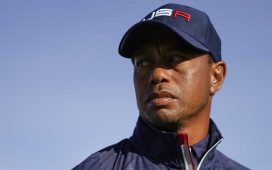There are a handful of places in the U.S. where golfers congregate in such numbers that we are the majority. At Pinehurst in North Carolina and Pebble Beach in California, announcing yourself as a proud golfer isn’t just accepted, it’s expected.
It’s the same in Palm Springs, California, and its neighboring communities, located a mere 90 miles southeast of Los Angeles. Here, golf is it. Tennis is popular, too, but the fairways, as far as many residents are concerned, are the essence of desert life.
Back in the day when we let our fingers do the walking and the Yellow Pages was an essential part of life, the local Palm Springs phone book dispersed golf tips on how to grip the club, keep your eye on the ball and follow through on the swing among the volume’s various classified ads. Now that’s a city consumed with golf, one that fills tee sheets with its geriatric golf-loving residents and visitors at more than 100 courses.
With its idyllic weather consisting of 350 days a year of sunshine, Palm Springs has been a tourist haven and Hollywood getaway since the 1920s. It is a desert oasis cradled between tall, picturesque mountains – the San Jacinto Mountains to the west, the Little San Bernardino Mountains to the east and the Santa Rosa Mountains to the south.
“The Desert” is what locals call Palm Springs, itself shorthand for the 30-mile string of seven communities – including Cathedral City, Rancho Mirage, Palm Desert, Indian Wells, La Quinta and Indio – that more or less ooze into each other and make up the Coachella Valley.

La Quinta Resort (Courtesy of La Quinta Resort)
Everything about Palm Springs, the best known and farthest west of the Desert communities, is dreamy, from the red bougainvillea draping the Spanish-style buildings to the renovated mid-century modern buildings giving it its charm. Running a close second to the smorgasbord of forgiving fairways in Palm Springs is its culinary treats. It can stand on its own two feet as a bona fide foodie destination. (Unfortunately, my trip was during the pandemic and restaurants were only doing takeout, so circumstances were less than ideal for reviewing the food.)
The palm trees that line streets named after Bob Hope, Frank Sinatra, Gene Autry and Dinah Shore really do sway in the breeze, and lounging poolside here is a sport, if not an art. Palm Canyon Drive, the main thoroughfare of Palm Springs, is packed with alfresco restaurants with views of the bustling sidewalks and the latest boutique shops.
Yes, in this bastion of Bentleys and bling, worldly pleasures rule. It begs a question of where to enjoy this paradise: to stay close enough to walk to the first tee, or in the heart of Palm Springs at any one of a handful of the decadent spa resorts? The answer is: Choices abound. Palm Springs tends to cater to those seeking a tax shelter, not a night’s shelter. Nonetheless, affordable lodgings are fairly abundant, especially in summer when the mercury rises into triple digits.

La Quinta Resort (Courtesy of La Quinta Resort)
Since the dual purpose of my visit was to watch the PGA Tour pros at The American Express in January, I set up shop in La Quinta, at the other end of the valley about a 45-minute drive to Palm Springs. La Quinta Resort is considered the granddaddy of them all. This posh hideaway introduced the first golf course to the Coachella Valley in 1926 and remains a gem. The 45-acre enclave, with 41 pools on property, 23 tennis courts, both hard and clay surfaces and a top-notch teaching staff, harks back to the golden era of Hollywood when film stars lined up at the door. Guests still gather in the lounge, with its deep sofas, high-vaulted beamed ceiling and wood-burning fireplace that gives off the fragrance of mesquite. In a day of high-rise mania, low-rise La Quinta with its quaint Spanish-Colonial style casitas rates at the very least five stars for service, five hearts for romance.
Golfers can thank Chicago attorney Leonard Ettelson for making the resort a golf destination. He bought the property in the mid-1950s, and when the course became too crowded for members and hotel guests, he hired Landmark’s Ernie Vossler and Joe Walser to develop the property’s golf resources. They built PGA West, a 2,000-acre golf and lifestyle community in La Quinta nicknamed the Western Home of Golf and where guests can play courses designed by Arnold Palmer, Tom Weiskopf, Pete Dye, Greg Norman and Jack Nicklaus.

The Greg Norman Course at PGA West in La Quinta, Calif. (Courtesy of La Quinta Resort)
Ownership of PGA West has changed hands numerous times over the past four decades for various reasons, with the New York-based private equity firm Blackstone Group in 2018 purchasing the club, along with nearby La Quinta Resort, a Waldorf Astoria property, from a Singapore government investment fund. The Singapore group reportedly had paid $1.5 billion for the properties in 2013. The five resort courses and two private clubs – PGA West Private Club and The Citrus Club –were acquired by Century Golf Partners for an undisclosed amount in a deal that closed in January 2020.
In its formative days, Vossler and Walser first recruited Dye to design and construct the most difficult course in the world. They picked the right guy. Dye once famously said, “Golf is not a fair game, so why build a course fair?”
The Mountain Course is carved at the base of the Santa Rosa Mountains, demanding accurate, strategic play in a spectacular setting. Some of the views are golf porn – the green grass, the starkness of the desert, the mountain ranges in the distance and blue skies. It’s an underrated Dye layout and one I could get used to playing on return visits.

The Mountain Course at La Quinta Resort in California (Courtesy of La Quinta Resort)
Vossler, a former PGA Tour pro and PGA professional of the year in 1967, is credited as the founder of the Mountain, Dunes and Citrus Courses at PGA West. When Dye was designing the Mountain’s treacherous, downhill par-3 16th hole, Vossler took one look at the stunning view and speck of land for a green and said, “We have to build this golf hole. It will be the best billboard La Quinta will ever have.” It has hosted the PGA Club Professional Championship, Senior Skins and World Cup.
A few years later, Dye outdid himself transforming a pancake-flat desert expanse into a sea of heaving mounds and a house of horrors. PGA West’s Stadium Course features 5,000 railroad ties, waste bunkers 200 yards long, water on nine holes and pot bunkers strewn everywhere. When the pros played it for the first time in competition at the 1987 Bob Hope Desert Classic, they pitched a fit like never before. Players signed a petition refusing to play there again, complaining the course featured more water than grass and was teeming with sand positioned in all the most inconvenient places. It took nearly 30 years for the course to return to the tournament rota at what is now formally known as the American Express.

The deep bunker on the left side of the 16th green at PGA West Pete Dye Stadium Course in La Quinta, Calif. (Tom Hauck/Icon Sportswire via Getty Images)
One of the more menacing hazards at the Stadium Course is named “the San Andreas Fault,” a bunker to the left of the 16th green that sits in the bottom of a 19-foot ditch. When Vossler caught wind of Dye’s latest Dye-abolical design, he thought he’d gone too far and demanded he make the bunker less penal. Dye declined. So, they made a wager. If Dye could extricate himself from the cavernous crater within 10 feet of the pin in three tries, the Fault would stay as is. Dye splashed his first attempt within two feet. As the legend goes, Vossler stormed off without saying a word.
When I played the hole, I managed to steer clear of the sand at 16, but I tossed three balls in it for giggles to see if I could match Dye’s effort to clear the steep slope. After three attempts rolled back to my feet, I conceded as former Speaker of the House Tip O’Neill had done years before in the pro-am, eventually throwing his ball out.
For masochistic types like myself who want to see if this crazy game can bring us to our knees, being told that Dye’s course was too tough for the pros and had the highest course rating/slope in the country made it all the more appealing. As golf writer Brian McCallen once wrote of Dye’s Stadium Course, “It’s not a golf course; it’s a bermudagrass Colosseum with 18 hungry lions poised to devour out-of-towners.”
It also didn’t hurt the course’s reputation that it hosted the Skins Game, including in 1987 when Lee Trevino made an ace at 17 and leaped into caddie Herman Mitchell’s arms in celebration. In other words, I’ve always wanted to play it.

The 18th green at the PGA West Stadium Course in La Quinta, Calif. (Taya Gray/The Desert Sun)
Dye’s course has been softened over the years – maybe too much for the best players in the world – but it remains a great test for us mere mortals. During the PGA Tour’s annual visit, I watched these modern-day gladiators in Soft Spikes play video-game golf at what once was considered the hardest course on the planet. On Sunday, Patrick Cantlay set the course record, shooting a once unfathomable 11-under 61.
I woke up at Zero-Dark-30 the next day for probably the earliest official tee time in my 40 years playing the game – 6:45 a.m. to be exact – and was first off the tee at PGA West with my high school buddy, who drove through a snow storm to get there, riding shotgun. Same course, same hole locations, same slick greens. I made my 61st stroke on my approach to 14.

Patrick Cantlay lines up a putt on the 17th green during the final round of The American Express at PGA West’s Stadium Course. (Harry How/Getty Images)
But at Alcatraz, the course’s infamous par 3, Cantlay hit a safe but unspectacular shot to 34 feet and made par. Yours truly? Well, I thought you’d never ask. Stuck it to four feet and rolled in the birdie putt less than 24 hours later. It’s the hole we’d been waiting for all day.
Alcatraz is a desert version of Dye’s famous island green at TPC Sawgrass in Florida. This one plays downhill to a tiny green surrounded by jagged rocks and water. The pros played it from 146 yards on Sunday – c’mon, let’s see these guys sweat from the back tee at 168 yards on payday – so that’s where I took dead aim and made my only birdie of the day. But if there’s only going to be one, that’s the hole you want to do it on. What Cantlay wouldn’t have given for that shot. One more birdie and he likely would have been in a playoff with American Express champion Si Woo Kim.
No. 18 is almost a replica of the finishing hole at TPC Sawgrass. One more rugged challenge before you get to add them up and weep. I made a pretty nifty up-and-down to post 79. That’s a good day for this 6-handicap with a fragile game and psyche to match. Plus, I beat Russell Knox’s prediction. After he shot 64 at the tournament, I asked him what a player of my caliber would score under tournament conditions, and he said mid-80s.
“It’s not an easy golf course if you don’t hit it where you’re looking,” he said.
It wasn’t even 10:30 a.m. and it was warming up, so we took on the Nicklaus Tournament Course at PGA West, which the pros played during one of the first two rounds. The Jack Nicklaus design felt like the equivalent of Dye’s Valley at TPC Sawgrass: It’s a really good course in its own right, but it’s not the Stadium Course. It’s like being Gal Gadot’s sister. She’s not Wonder Woman. But to hear Nicklaus tell it, he succeeded in his chief objective.

The Nicklaus Tournament Course at PGA West in California (Courtesy of La Quinta Resort/Rob Perry)
“One of the greatest compliments paid to a designer is when you can create a golf course that is fun and challenging and memorable for its members and guests, but for a week out of the year, you can hide the pins and put the tees back and that same course becomes a good test for tournament golf,” Nicklaus said. “I think we accomplished that difficult balance.”
The Nicklaus Tournament Course typically surrenders lower scores, but the putting surfaces were redone last year and firm greens mitigated some of the difference in scoring this year. It’s a bit more forgiving, especially off the tee, but there still are some potentially penal forced carries over water at par 3s and a peninsula green at the par-5 15th that makes for a great risk-reward hole, and it’s extremely demanding around the greens. The finishing holes on both sides share a green and a lake that can ruin a good round.
I deposited a sleeve at 18, which was good because my bag was going to be over the weight limit on my flight home. At least that’s what I told myself afterwards.








